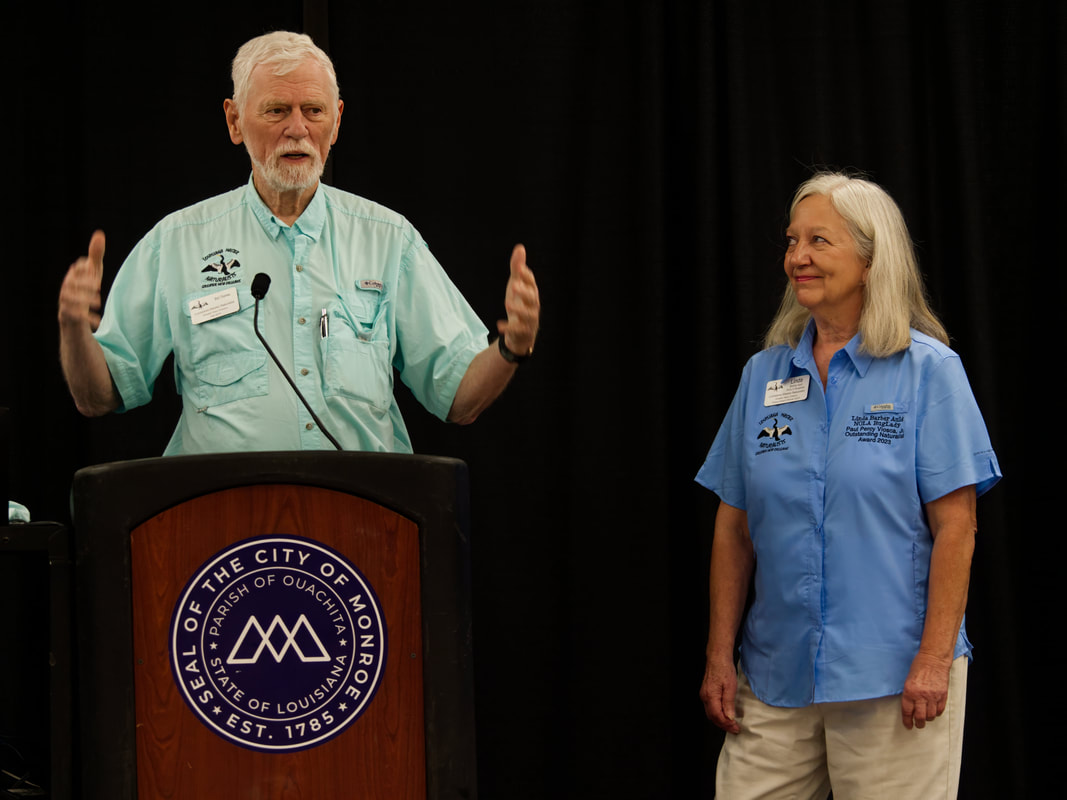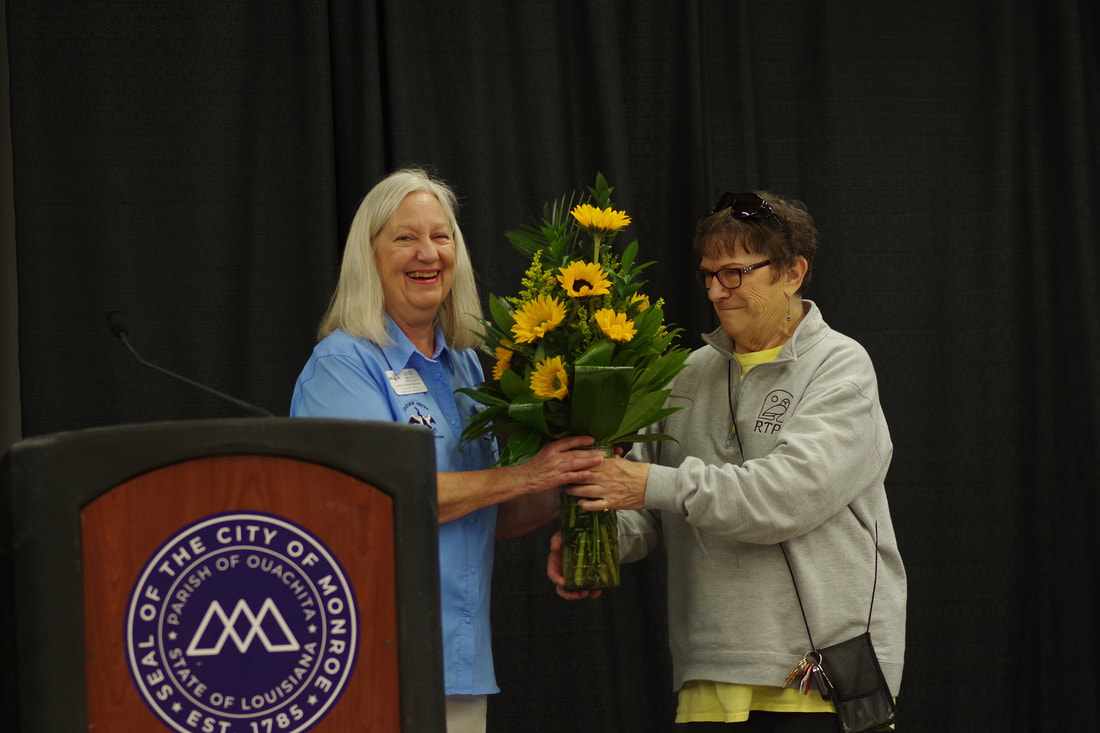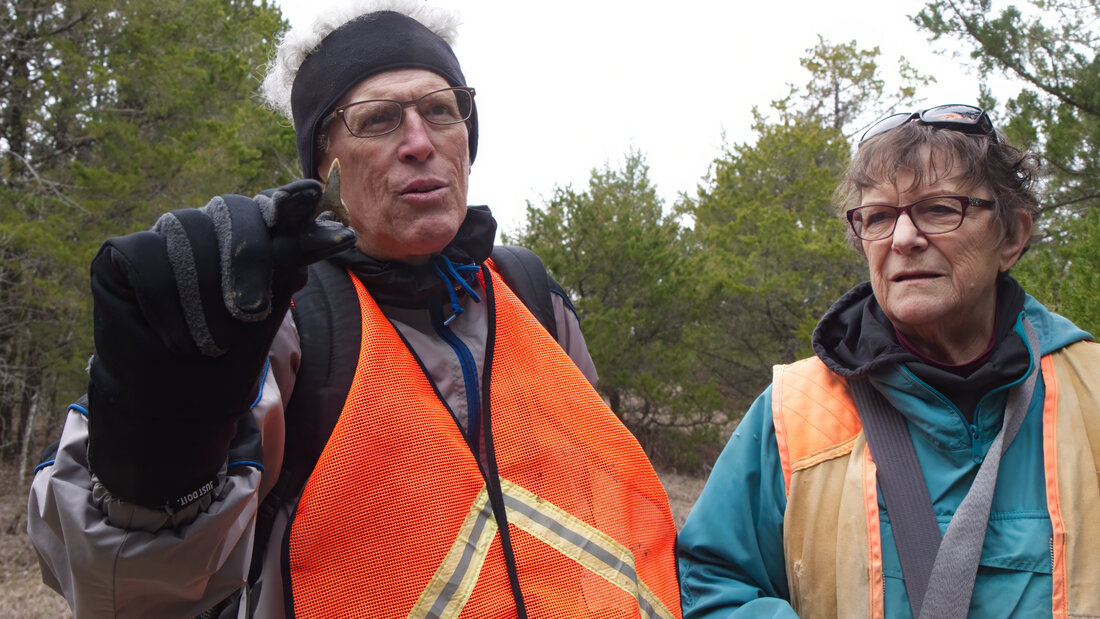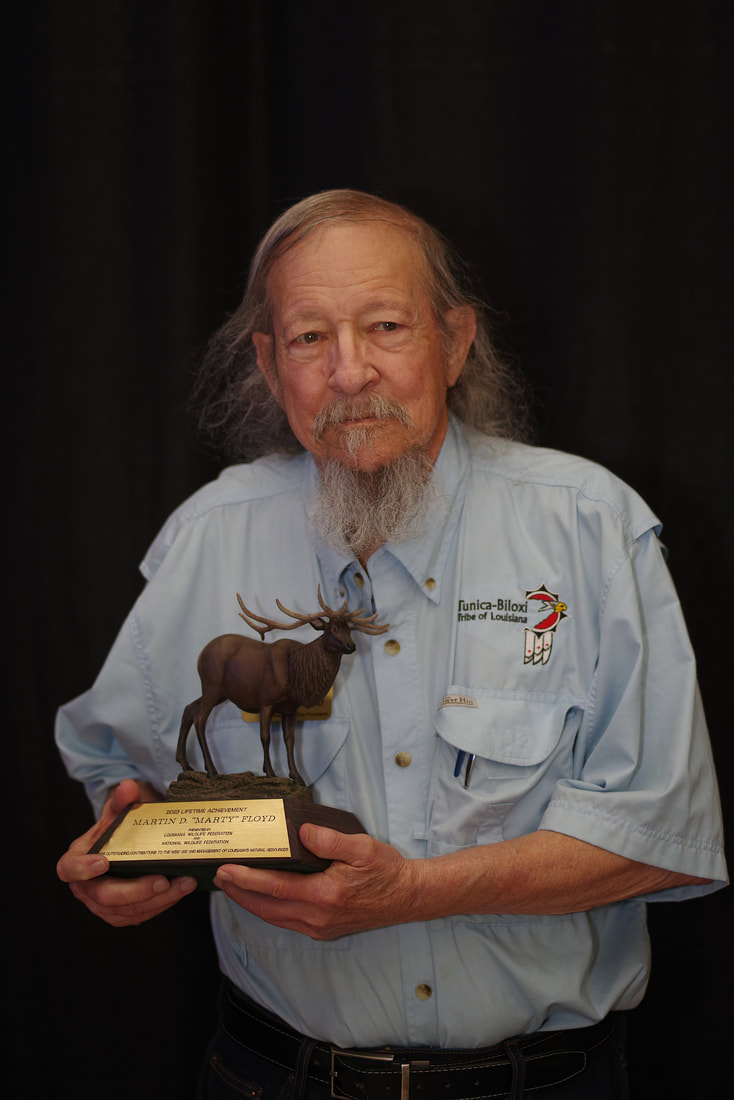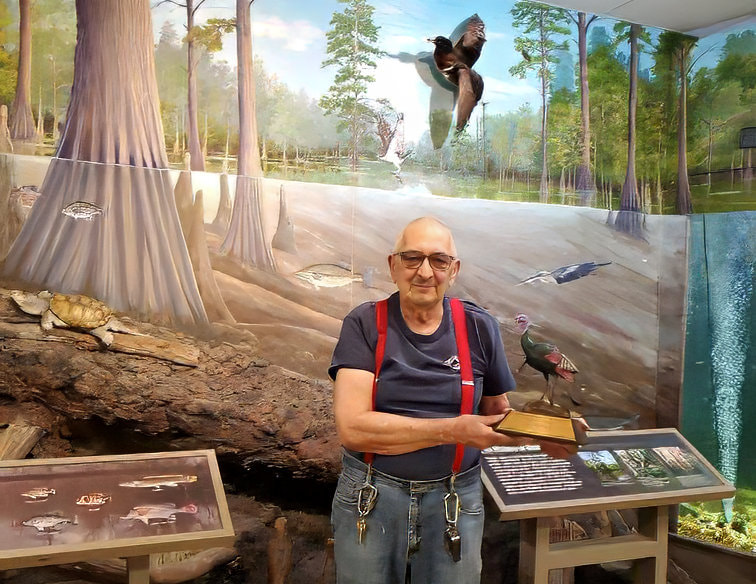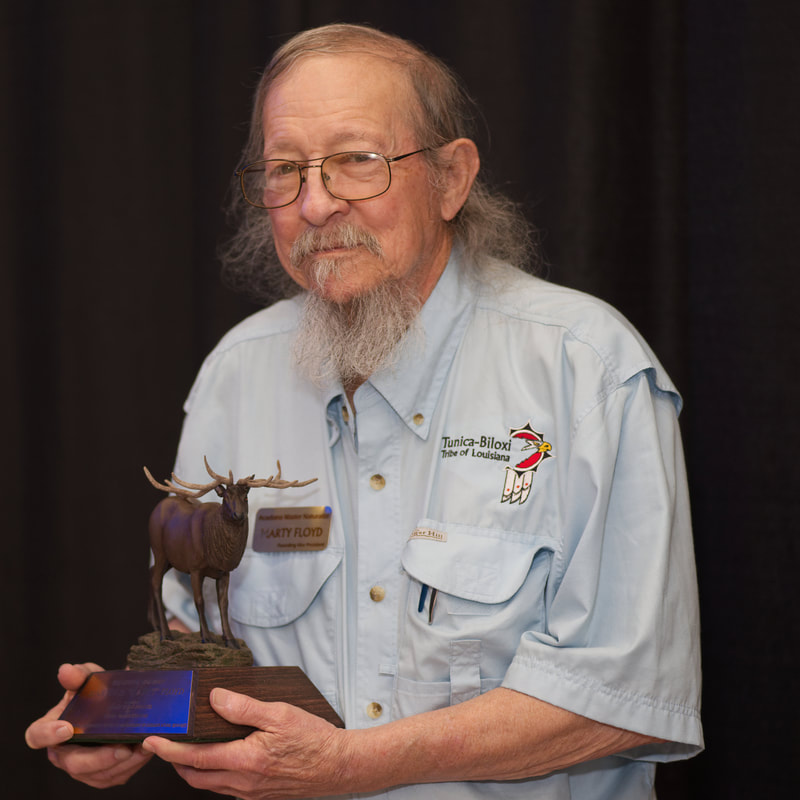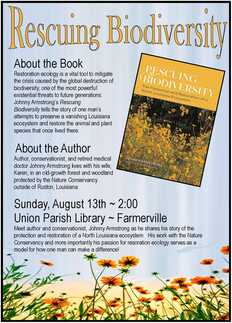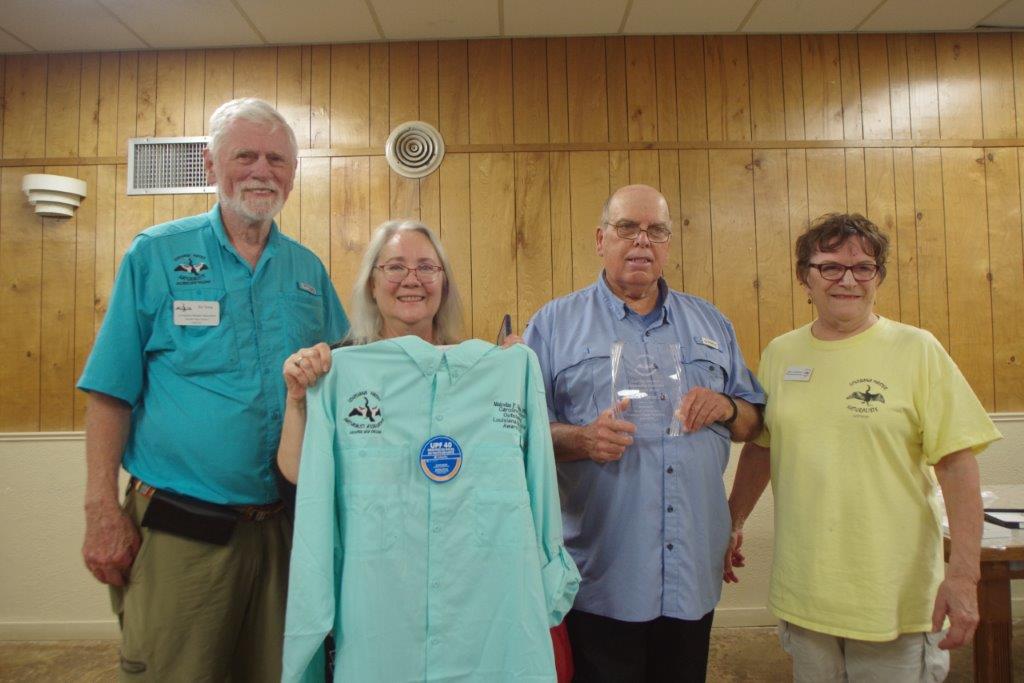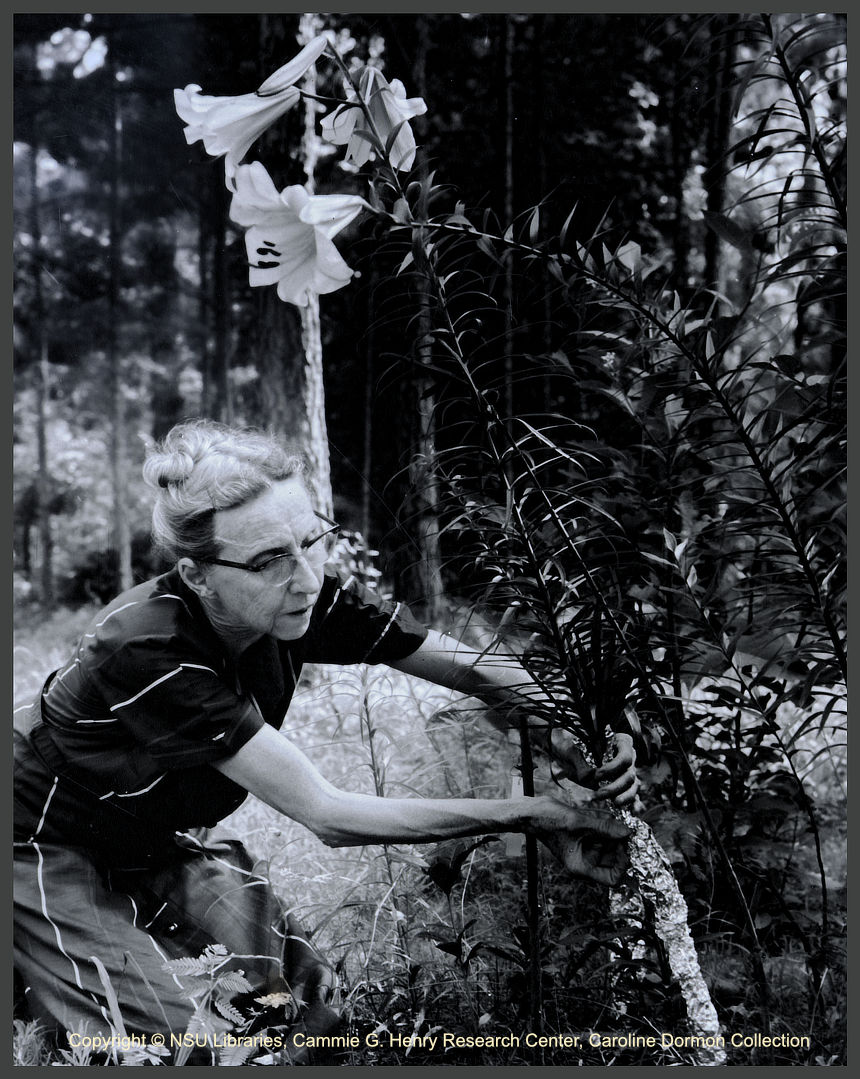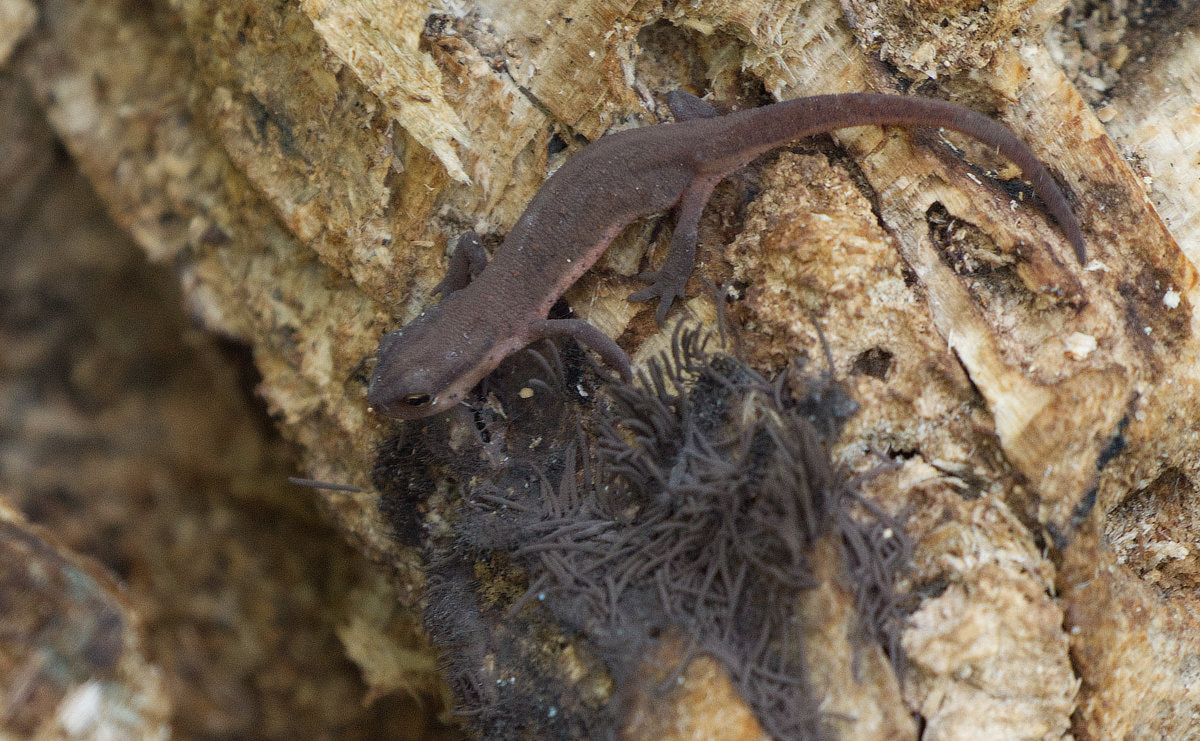|
Saturday, April 13, 2024 in Monroe , LA. LMNA Past-president Dr. Bob Thomas introduced our guest speaker, the Outstanding Louisiana Naturalist of the Year Linda Barber Auld. Auld won by a landslide for her admirable and transformative work in butterfly conservation and education!
Her presentation exemplifies a life increasingly dedicated to education and service on behalf of the nation's beleaguered butterflies! See The Dormon Award for the press release!
0 Comments
By C.Paxton Apologies in advance for any errata written here are my own. 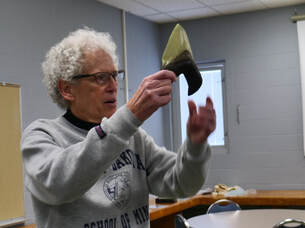 Louisiana Master Naturalists Northeast enjoyed an excellent Geology Workshop February 17th, 2024, given by Dr. Gary Stringer, ULM Professor Emeritus of Geology. The subject was "The Prehistoric Megatoothed Sharks of Louisiana" and his illustrated talk was informative and highly stimulating! Dr. Stringer has discovered a great many marine fossils in the course of his research including great sharks' teeth, the spines and crushing teeth of rays, the ear-stones (Otoliths) of fish and the bones of huge prehistoric whales! His publications have firmly established that the Yazoo Clay deposits in the Copenhagen Hills near Columbia are one of the Southeast's richest repositories of Late Eocene fossils including the remains of great sharks and whales, the apex predators of the age! Our lecture conveyed a great introduction to the taxonomy, range and ecological interactions of the giant prehistoric sharks that inhabited the area that we know as Louisiana in the late Eocene. It was fascinating to focus on the physiological characteristics of the teeth. 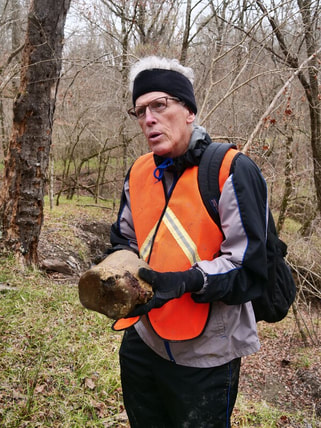 Dr. Gary Stringer holding the caudal vertebra of an extinct Basilosaurid Whale, Basilosaurus cetoides that he had just found! Dr. Gary Stringer holding the caudal vertebra of an extinct Basilosaurid Whale, Basilosaurus cetoides that he had just found! The classroom portion was conducted at ULM's Hanna Hall, and the field trip was held with special permission at Nature Conservancy Louisiana's Copenhagen tract, Caldwell Parish, not far from the Ouachita River. Despite low temperatures and high winds, it was a great success! Our group leaders wore Orange vests and the fossils were found on the surface without disturbance of the soil or vegetation. Dr. Stringer was kind and thorough in his examination and identification of the specimens that we found, he also kindly presented LMN-NE with some of his finds for the display that will enrich the group's outreach events! Overview: The invertebrate and vertebrate fossils were collected on the surface with no disturbance of plants or soil. The invertebrate fossils were more numerous, which is typical. All invertebrate and vertebrate specimens recovered have been previously described from the site by various researchers and studies, i.e., no new species were found. Furthermore, no unique or rare specimens were recovered on the field trip. The fossils were common and abundant. At the conclusion of the field trip, Dr. Stringer identified the findings of each participant. Results are given below for the entire group including Dr. Stringer. Taxa and number found: Invertebrates Coelenterates (corals) Balanophyllia irrorata (39 specimens, the most abundant coral at the site) Flabellum cuneiforme (27 specimens) Endopachys maclurii (2 specimens) Archohelia sp. (3 specimens) Bivalves (shells): Venericardia planicosta (24 specimens) Cubitostrea trigonalis (46 specimens, primarily broken; oyster shells) Glycymeris sp. (1 specimen) Chlamys nupera (2 specimens, broken) Thaumastoplax sp. (2 specimens) Atrina jacksoniana (3 specimens; internal casts) Teredo sp. (10 specimens) Gastropods (shells) Calyptraphorus relatus (2 specimens) Clavilithes humerosus (4 specimens) Architectonica alveata (1 specimen) Athleta petrosa (1 specimen) Pseudoliva vetusa (1 specimen, broken) Turritella sp. (14 very small specimens) Scaphopods (tusk shells) Dentalium mississippiense (1 specimen) Trace fossil Burrow (unknown origin) (2 specimens) Vertebrate remains Myliobatis (1 small specimen of crusher tooth of eagle ray) Shark coprolites (10 specimens; fossilized fecal material) Shark teeth (4 specimens; 3 of Isurus and 1 of Carcharhinus) Basilosaurus cetoides (whale remains; several small pieces of non-identifiable bone; 2 small pieces of ribs; one partially complete vertebra) Zygorhiza kochii (small whale at Copenhagen; possible part of centrum of a small vertebra) Some of the particles that washed off our specimens included the following microfossils that Dr. Stringer kindly identified as Foraminifera, commonly called 'Forams'; he explained these were amoebae that could secrete calcium carbonate. 3/10/2024 0 Comments Louisiana Wildlife Federation Awards Dr. Alex Kolker Conservationist of the Year!
The Louisiana Master Naturalists would like to extend our congratulations to, and celebration of, the eight Conservation Achievement Awards winners for 2003. The following information is based on an LWF Press Release (BATON ROUGE, February 24, 2024). The winners were carefully selected by a panel of independent judges with expertise in a wide range of conservation fields! The Louisiana Wildlife Federation will present the 58th Conservation Achievement Awards on April 12 Coastal Researcher, Dr. Alex Kolker has been named 2023 Conservationist of the Year! Alex Kolker, PhD, of New Orleans, and associate professor at the Louisiana Universities Marine Consortium (LUMCON), specializing in oceanography, geology, and climate science, has been named 2023 Conservationist of the Year by the Louisiana Wildlife Federation. Dr. Kolker recently led the charge for collecting data to better understand the continuing evolution of Neptune Pass in the lower Mississippi River and related land-building. He also developed a new tool showing the sources of major greenhouse emissions and other pollutants in the state. “Dr. Kolker’s contribution to the research needed to better understand how we can use the Mississippi River to build land and the potential local impacts from climate change continues to be crucial in planning efforts,” said LWF Executive Director Rebecca Triche. “He is also a powerful and effective science communicator using social media to engage people.” The Conservationist of the Year Award is presented annually to the person, business or organization deemed to have made the most outstanding contribution toward the protection, wise use, and enjoyment of Louisiana’s natural resources from among nominees submitted by the public. Conservationist of the Year is the most prestigious conservation award in Louisiana. Along with recognizing the 2023 Conservationist of the Year, Louisiana Wildlife Federation will also present seven other Conservation Achievement Awards at its 58th Awards Banquet to be held on April 12 in Baton Rouge. The program added a category for Lifetime Achievement Award this year and the inaugural award will be presented to Martin D. “Marty” Floyd of Cheneyville for his decades of professional and volunteer service toward conserving Louisiana’s wildlife and native habitat. Floyd, a wildlife biologist, has contributed greatly to habitat and wildlife conservation work for more than 50 years. His long career includes work for the USDA Natural Resources Conservation Service, Louisiana Department of Wildlife and Fisheries, and Ducks Unlimited, and he has given decades of volunteer leadership to numerous organizations, including Louisiana Ornithological Society, Louisiana Association of Professional Biologists, Louisiana Master Naturalists Association, Louisiana Wildlife Federation, and National Wildlife Federation. For more on Marty's win, please see LWF CONSERVATION AWARDS ANNOUNCED TODAY The other six 2023 Conservation Achievement Awards recipients include:
LWF would like to thank the 58th Conservation Achievement Awards Banquet sponsors including Lamar Advertising; Land Trust for Louisiana/Southern Heritage Wild, LLC; Cenac Marine Services; Delacroix Corporation; Louisiana Lottery Corporation; Rapides Wildlife Association; Toledo Bend Lake Association, and Robert and Norma Stewart. The public is invited to the 58th Conservation Achievement Awards Banquet to be held on Friday, April 12, 2024, at Boudreaux’s in Baton Rouge. The banquet will begin at 6:00 pm with a cocktail reception followed by dinner and the awards presentation at 7:00 pm. The Master of Ceremonies will be Rob Shadoin, former Secretary of the Louisiana Department of Wildlife and Fisheries. For more details and to purchase tickets visit at lawildlifefed.org! The Louisiana Wildlife Federation is a statewide conservation education and advocacy organization established in 1940, with more than 10,000 members and 21 affiliate groups representing a broad constituency of hunters, anglers, birders, boaters, campers, hikers, and other outdoor enthusiasts. You might consider membership, if you haven't joined them already.
Fantastic news that the LMNA's Marty Floyd has scooped the Louisiana Wildlife Federation's Lifetime Achievement Award! According to LWF, their judges for the 58th Conservation Achievement Awards met Saturday, February 17th, and have selected the following winners in each category: Conservationist of the Year for 2023 – Alexander Kolker, PhD. (See next blog article for LWF Press Release!) Professional Conservationist of the Year for 2023 – Corey Miller Volunteer Conservationist of the Year for 2023 – Jim Kolinski Conservation Educators of the Year for 2023 – Amanda Clark & Pam Pearce Elected Official Conservationist of the Year for 2023 – Joseph Orgeron, PhD. Conservation Communicator of the Year for 2023 – Don Shoopman Conservation Organization of the Year for 2023 – AJ & Nona Trigg Hodges Foundation 2023 Lifetime Achievement – Marty Floyd The LWF awards program recognizes "individuals, organizations, and businesses that have made a significant and outstanding contribution toward the protection and wise use of Louisiana’s natural resources in the previous year. Each honoree will receive a handsome wildlife statuette. The recipients will be honored at a celebratory banquet at Boudreaux's held in Baton Rouge on April 12, 2024. It's worth noting some of Marty's many and formidable achievements and qualifications for winning this award, though quiet and very modest, he has been a leading light in Louisiana environmental conservation. Marty has a proven track record of tangible and positive impact on wildlife conservation in Louisiana for 25 years! Dr. Bob Thomas, the LMNA's Past President, and Professor & Director of The Center for Environmental Communication at Loyola University in New Orleans commented, "Marty has dedicated his career and passions to the conservation and understanding of Louisiana’s magnificent Sportsman Paradise. The value of his work is unparalleled!" Marty's service includes Presidency of LOS and LWF, Louisiana Master Naturalist State board membership and regional board membership for Acadiana Chapter (Lafayette Region) as a prime mover there and in the CenLA region. He has consistently exhibited leadership and been an active environmental volunteer and advocate. He has steered group policy and contributed his knowledge to a great many excursions and workshops. I was very impressed by his owl calls at our Fontainebleau Rendezvous! He privately published and has widely disseminated two delightful bird books written by his father: All About Cardinals and All about Bluebirds. His Bird Counts have contributed to regional biodiversity mapping. His conservation work as Program Manager for the LDWF program to study the impact on habitat damaged by the BP Deepwater Horizon oil spill has had lasting impact. As Ducks Unlimited liaison he enrolled landowners in the Natural Resources Conservation Services (NRCS) Migratory Bird Habitat Improvement Program for EQIP (Environmental Quality Incentive Program) to make alternate habitats for birds displaced due to the oil spill. In 2003 Marty helped locate and monitor Sandhill Cranes with the Loose Alliance of Casual and/or Keen Bird Watchers of Central LA. Marty Floyd was a contributor to the 2005 Louisiana Wildlife Action Plan and was recognized at the Coalition to Restore Coastal Louisiana’s Coastal Stewardship Awards Banquet for his 25 years working with the coastal marshes! Marty has thus unquestionably made a lasting and sustainable impact on wildlife and their coastal habitats, ensuring a positive legacy for future generations! Along with these qualifications, his contributions to environmental education and community outreach firmly align him with this great award. Working with the NWF, Rapides Wildlife Association, LWF and Tunica Biloxi Tribe of Louisiana Marty has co-created a wonderful coloring book that has both the English and Native American Tunica-Biloxi names of many of Louisiana's wild creatures. Marty provided the original images for coloring. This book is available online and is used by individuals with their families and educators. It has been shared widely and is an exemplar of educational material that constitutes an important cross-cultural bridge! LMNA President Bette Kauffman speaks for us all in congratulating him on a very well-deserved award! "Marty Floyd is a consummate conservationist. His lifetime of commitment and work to preserve the natural heritage of this state has left us all richer. We are delighted to celebrate with him LWF's 2023 Lifetime Achievement.award. Congratulations, Marty! We are proud of you." When asked how he feels about it, Marty said "So honored to be chosen for this award. I don't plan on stopping in whatever way I can to promote wildlife and the habitat they depend upon. Thanks for all the support I have been given." To which we respond, thank you, Marty, for your long years of excellent work in, about and for the environment in Louisiana and for being such a fine Master Naturalist exemplar! Kudos to you, sir! A good volunteer effort for master naturalists would be monitoring tall buildings during migration to find dead birds as part of LIGHTS OUT program.
Volunteers would need to look in early morning hours using birdcast and bad weather reports when birds are pushed down as result of poor visibility and collide with lighted buildings. Bird cast is a free app (https://birdcast.info) with live data March 1 to June 15 and Aug 1 to Nov 15. Go to: Louisiana, then to the parish Combine this with bad weather reports. Marty Floyd
Armstrong is running an exemplary project in cooperation with The Nature Conservancy Louisiana to preserve a vanishing Louisiana ecosystem and restore the indigenous plants and animals. This is important because America is losing its precious biodiversity from habitat destruction; both the variety and the quantity of living things are being diminished. A rich biodiversity is more resilient to adverse changes and is the basis of our life support system. Therefore, this event is relevant for all who own or manage land in NELA. We're very grateful to Johnny for his valuable project and outreach, and also to Library Director, Stephanie Antley Hermmann for opening this wonderful venue to us. Yet again she's proving Louisiana public libraries' essential contribution to our NELA community. There'll be an opportunity for Q&A and book signing and an appeal to join the Louisiana Master Naturalists Northeast group. Links and background information For more info about Johnny's book please see: https://lsupress.org/books/detail/rescuing-biodiversity/ More info about The Louisiana Master Naturalists: The Louisiana Master Naturalists Northeast's mission is to develop a corps of well-informed citizen naturalists who promote, through education and service, stewardship of Louisiana’s natural resources within their communities. https://louisianamasternaturalistsnortheast.com More info about the Union Parish Library here: The Union Parish Library is located in central Farmerville, Louisiana. It regularly holds events and is a valuable community hub https://unionparish.booksys.net/opac/upl/index.html#menuHome
4/29/2023 0 Comments Dr. Malcolm F. Vidrine is The Caroline Dormon Outstanding Louisiana Naturalist of The Year for 2023!By Dr. Robert A. Thomas PhD. Professor of Environmental Communication, Loyola University, LMNA Past President and Chair of The Dormon Award Committee. The Louisiana Master Naturalist Association, a statewide organization dedicated to educating citizens about the natural history of our state and its importance to their well-being, is proud to announce that the 2023 recipient of its Caroline Dormon Outstanding Louisiana Naturalist award is Dr. Malcolm F. Vidrine, professor emeritus of biology at Louisiana State University Eunice. He received the award April 22 at LMNA’s annual Rendezvous held in Hackberry, Louisiana, and hosted by the Southwest Louisiana Master Naturalists.
2/6/2023 0 Comments LMNA Seeks Your Nominations For Outstanding Louisiana Naturalist 2023 - The Caroline Dormon Award.Who do you feel deserves the Caroline Dormon Outstanding Louisiana Naturalist Award 2023?
9/5/2022 0 Comments Find out about fireflies, frogs, 'gators, hurricanes and lot's more besides from The Southern Naturalist Podcast Series.
https://www.redriverradio.org/show/conserving-earth/2022-05-17/conserving-earth-may-18-2022-master-naturalists Check out this excellent radio interview with The Louisiana Master Naturalists. Join Red River Radio's Rebecca Triche in a superb Conserving Earth chat program with LMNA President Bette Kauffman, Katherine Gividen LMNA Vice President, and Janell Simpson, Greater New Orleans MN President. The discussion covers all aspects of becoming and being a Master Naturalist in Louisiana, why it is so worthwhile and the sort of activities that we do in a lively and informative dialogue!
This is recommended listening for anyone interested in the Louisiana Master Naturalists! |
LMNA News BlogWelcome to the Louisiana Master Naturalist Association News Blog. Archives
April 2024
Categories |
||||||||||||||||||||||||||||||||
Search by typing & pressing enter
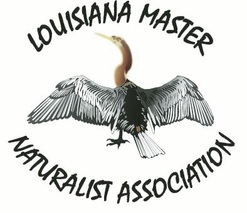
 RSS Feed
RSS Feed
